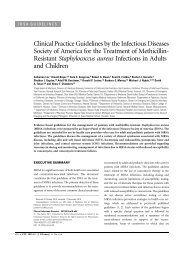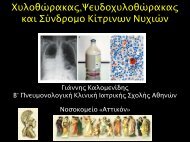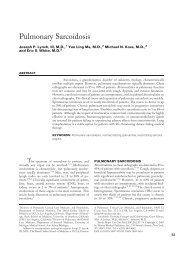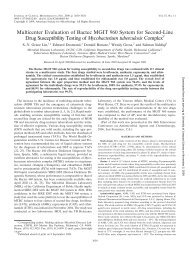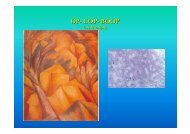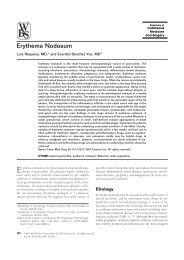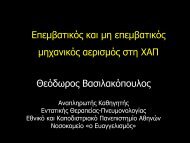010401 Allergy and Allergic Diseases
010401 Allergy and Allergic Diseases
010401 Allergy and Allergic Diseases
Create successful ePaper yourself
Turn your PDF publications into a flip-book with our unique Google optimized e-Paper software.
ADVANCES IN IMMUNOLOGY<br />
GATA-3<br />
c-maf<br />
PGE 2<br />
Nitric oxide<br />
Th2<br />
IFN-g<br />
High-affinity<br />
interactions<br />
between T cells <strong>and</strong><br />
antigen-presenting cells<br />
<br />
Large amount<br />
of antigen<br />
<br />
Interleukin-4 Interleukin-10 <strong>and</strong> TGF-b Interleukin-12<br />
Interleukin-18 <br />
Low-affinity<br />
interactions<br />
between T cells <strong>and</strong> <br />
antigen-presenting cells<br />
<br />
Small amount<br />
of antigen<br />
<br />
Th1<br />
CpG repeats from<br />
bacterial antigens<br />
Figure 1. Immunologic <strong>and</strong> Cellular Factors Regulating the Expression of Th1 <strong>and</strong> Th2 Cells.<br />
Whether the immune response is dominated by Th1 or Th2 cells is dependent on interleukin-12 <strong>and</strong> interleukin-4, respectively, as<br />
well as on the avidity of interactions between T cells <strong>and</strong> antigen-presenting cells <strong>and</strong> the amount of allergen to which the immune<br />
system is exposed (antigen). 13,14 In addition, the presence of cytidine–phosphate–guanosine (CpG) repeats derived from bacteria<br />
favors the Th1 phenotype, whereas the presence of transcription factors such as GATA-3 favors the Th2 phenotype, 15 as does the<br />
presence of c-maf <strong>and</strong> prostagl<strong>and</strong>in E 2<br />
(PGE 2<br />
). Nitric oxide favors the expression of Th2 cells by being less inhibitory to Th2 cells<br />
than Th1 cells, whereas in humans interleukin-10 <strong>and</strong> transforming growth factor b (TGF-b) generally dampen the responses of both<br />
types of cells. Interferon-g (IFN-g) inhibits Th2-mediated responses; both interleukin-12 <strong>and</strong> interleukin-18 release interferon-g from<br />
T cells. Interleukin-4 inhibits the expression of Th1 cells <strong>and</strong> promotes Th2-mediated responses. Green arrows indicate stimulatory<br />
effects, <strong>and</strong> red arrows inhibitory effects, of the cytokines.<br />
many. 17 This phenomenon raises the possibility that<br />
a Western lifestyle accounts for the increases in prevalence.<br />
Perhaps in Western countries the developing<br />
immune system is deprived of the microbial antigens<br />
that stimulate Th1 cells, because the environment is<br />
relatively clean <strong>and</strong> the use of antibiotics for minor<br />
illnesses in early life is widespread. 18<br />
The results of epidemiologic studies support this<br />
theory. Evidence that the bacteria that colonize the<br />
gastrointestinal tract prevent atopic sensitization was<br />
found in studies of one-year-old infants in countries<br />
with a low prevalence of atopy (Estonia) <strong>and</strong> a high<br />
prevalence (Sweden). Lactobacilli <strong>and</strong> eubacteria predominated<br />
in Estonian infants, whereas clostridia were<br />
more frequent in Swedish infants. 19 When studied one<br />
year later, the children with atopy were colonized<br />
less often by lactobacilli <strong>and</strong> had higher levels of aerobic<br />
bacteria (such as coliforms <strong>and</strong> Staphylococcus aureus)<br />
than children without atopy. 20 Moreover, atopy<br />
<strong>and</strong> allergic asthma were less frequent in populations<br />
exposed to Helicobacter pylori, Toxoplasma gondii, <strong>and</strong><br />
hepatitis A virus. By producing an environment rich<br />
in interleukin-12, these microbes could drive a Th1-<br />
mediated response. This mechanism may explain why<br />
in Europe <strong>and</strong> Africa, farming or living in a rural<br />
community, which increases the likelihood of exposure<br />
to bacteria found in barns, protects against atopic<br />
disease. 21<br />
Other factors that may favor the Th2 phenotype<br />
in infants include diet <strong>and</strong> being born when pollen<br />
counts are high. 22 Furthermore, atopic allergic diseases<br />
are less common in younger children who have<br />
three or more older siblings <strong>and</strong> among children who<br />
have had measles or hepatitis A — another indication<br />
that repeated immune stimulation may protect against<br />
atopic allergy. 23 This view is supported by the study<br />
by Ball et al., who provided evidence that exposure<br />
of young children to older children at home or to<br />
other children at day-care centers protected against<br />
the development of asthma <strong>and</strong> frequent wheezing<br />
in childhood. 24<br />
This “hygiene” hypothesis is not easily reconciled<br />
N Engl J Med, Vol. 344, No. 1 · January 4, 2001 · www.nejm.org · 31<br />
Downloaded from www.nejm.org by VASSILAKOPOULOS THEODOROS MD on April 1, 2009 .<br />
Copyright © 2001 Massachusetts Medical Society. All rights reserved.



